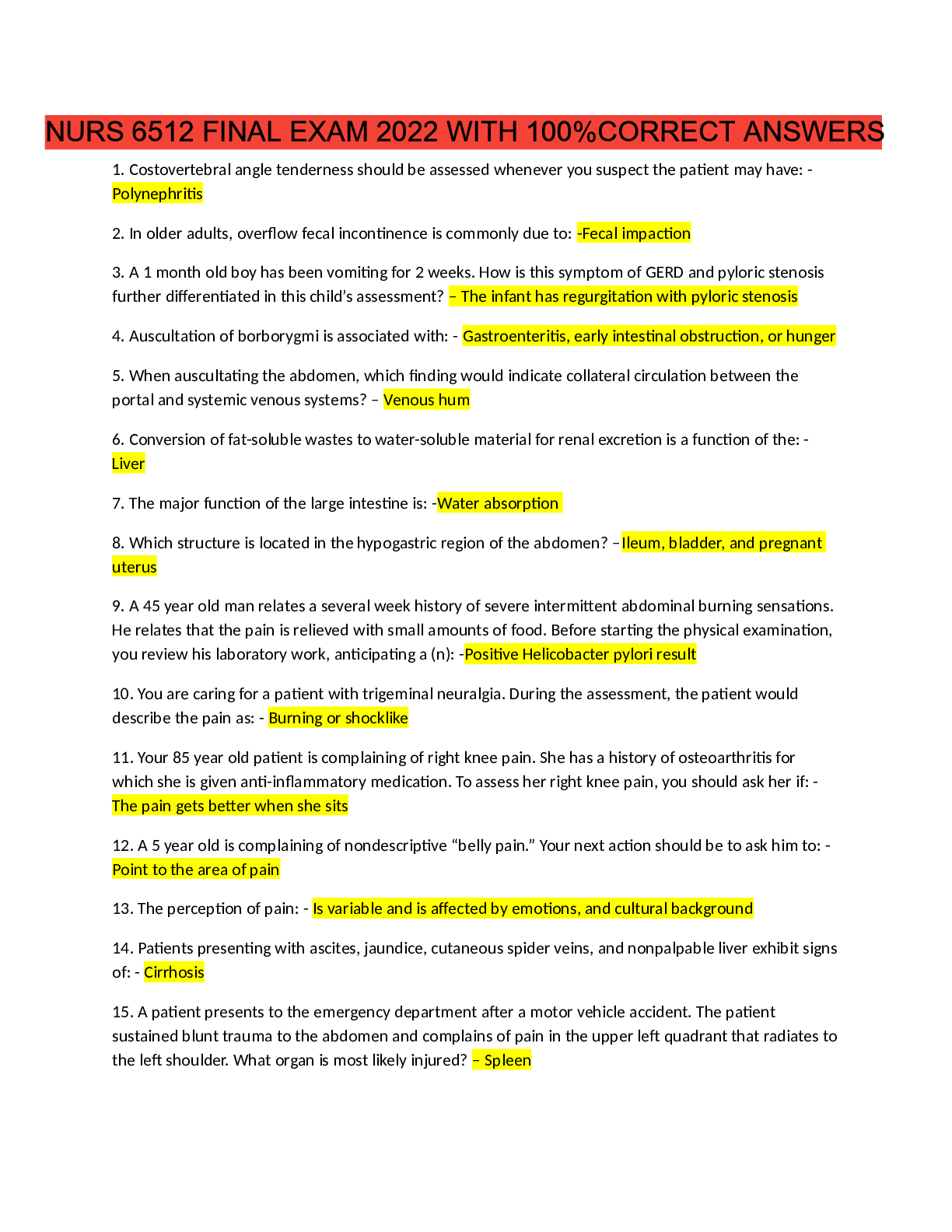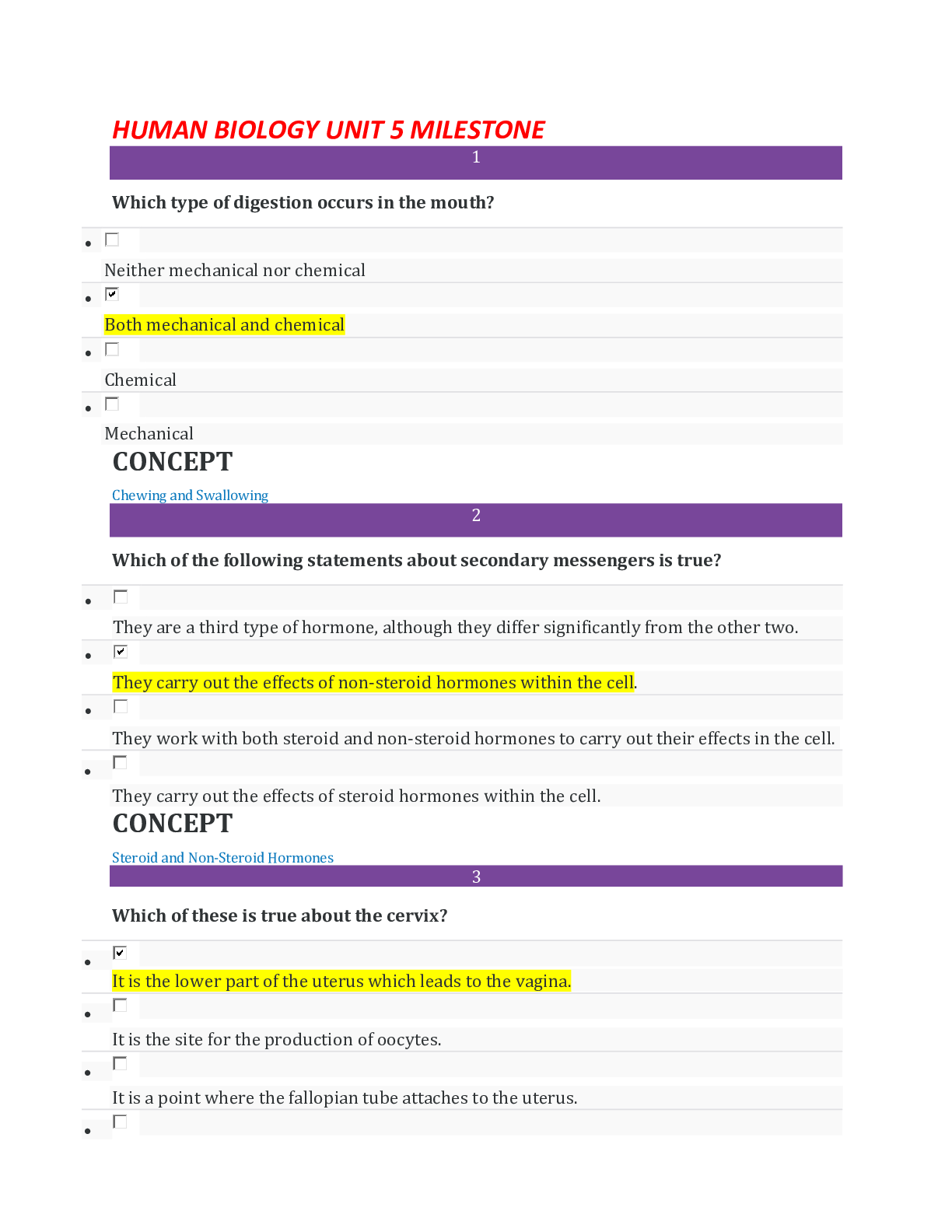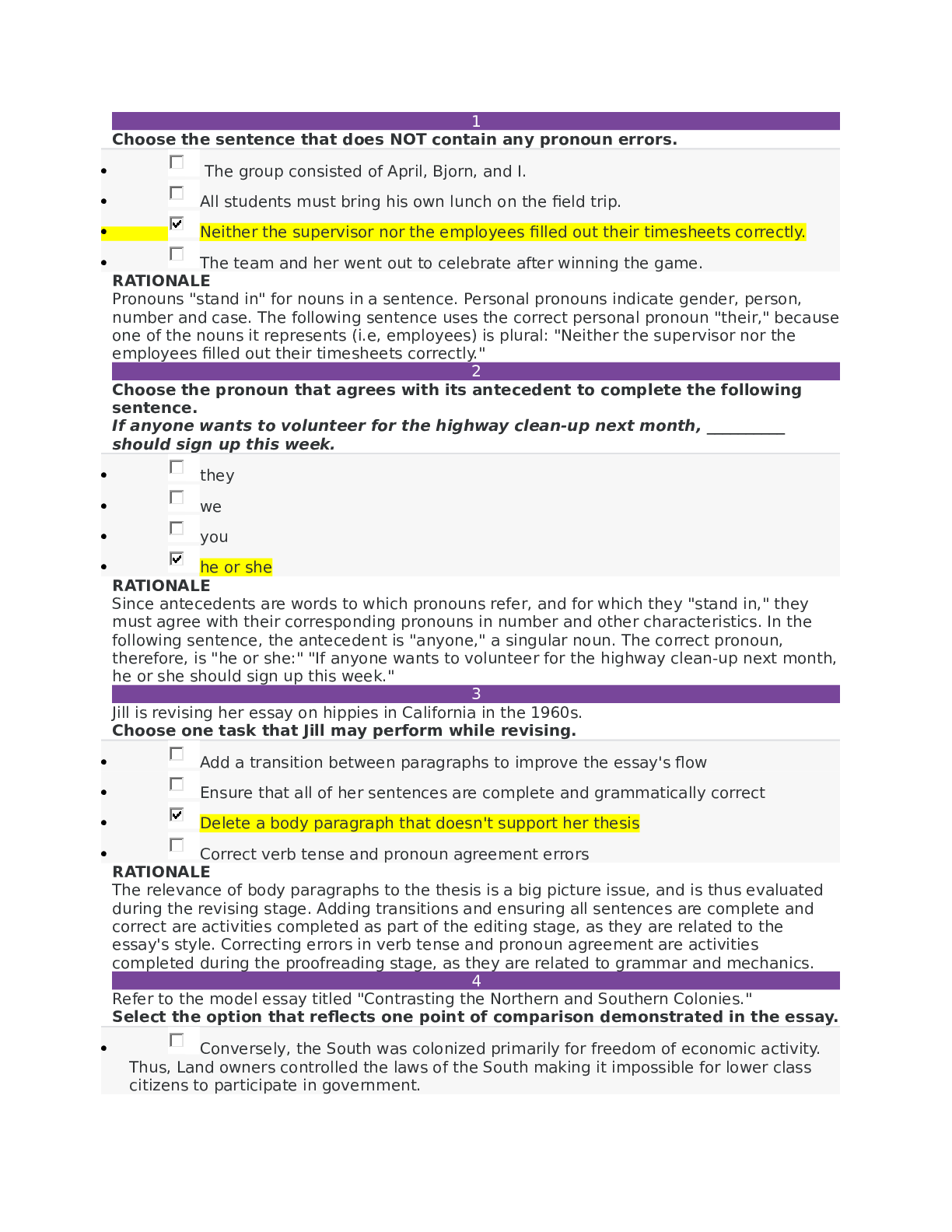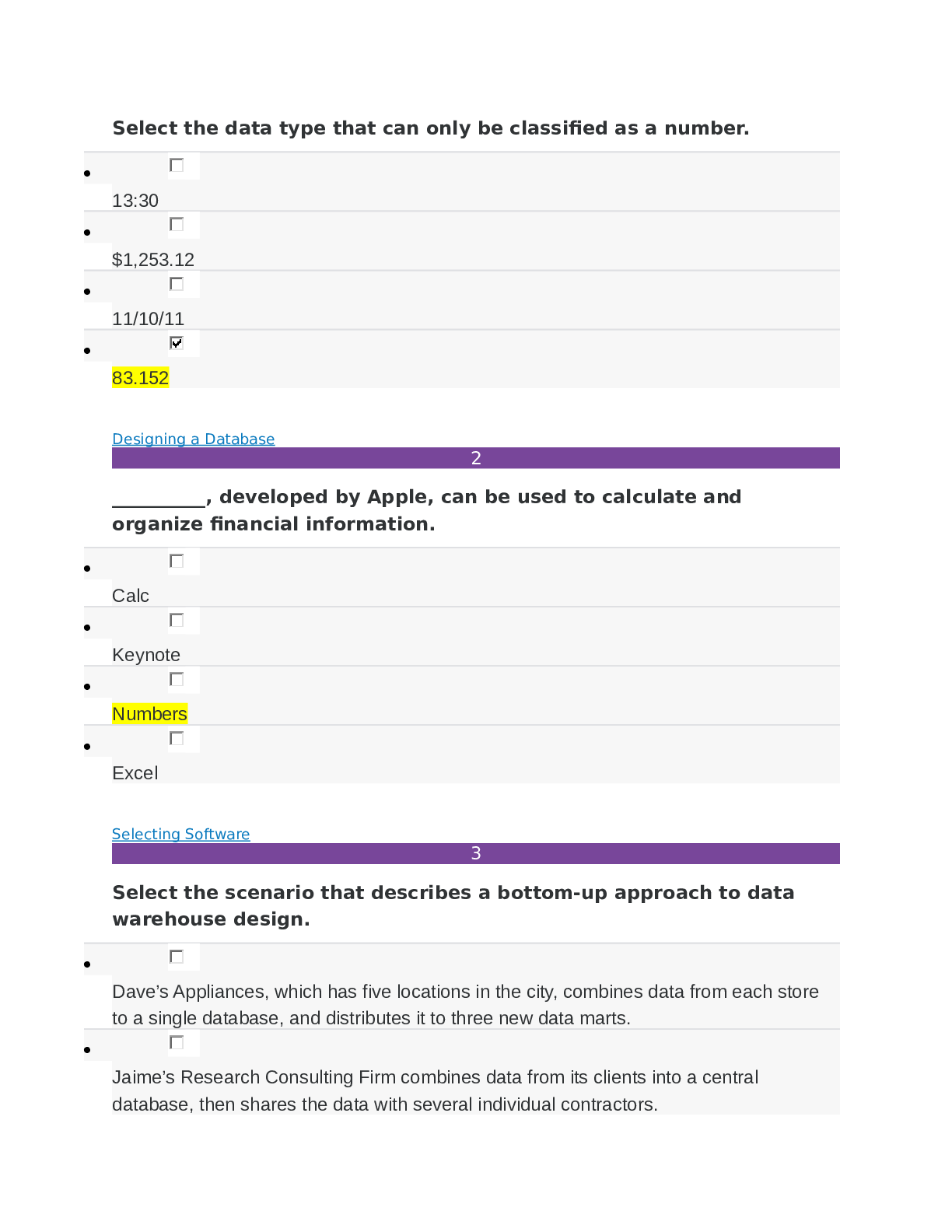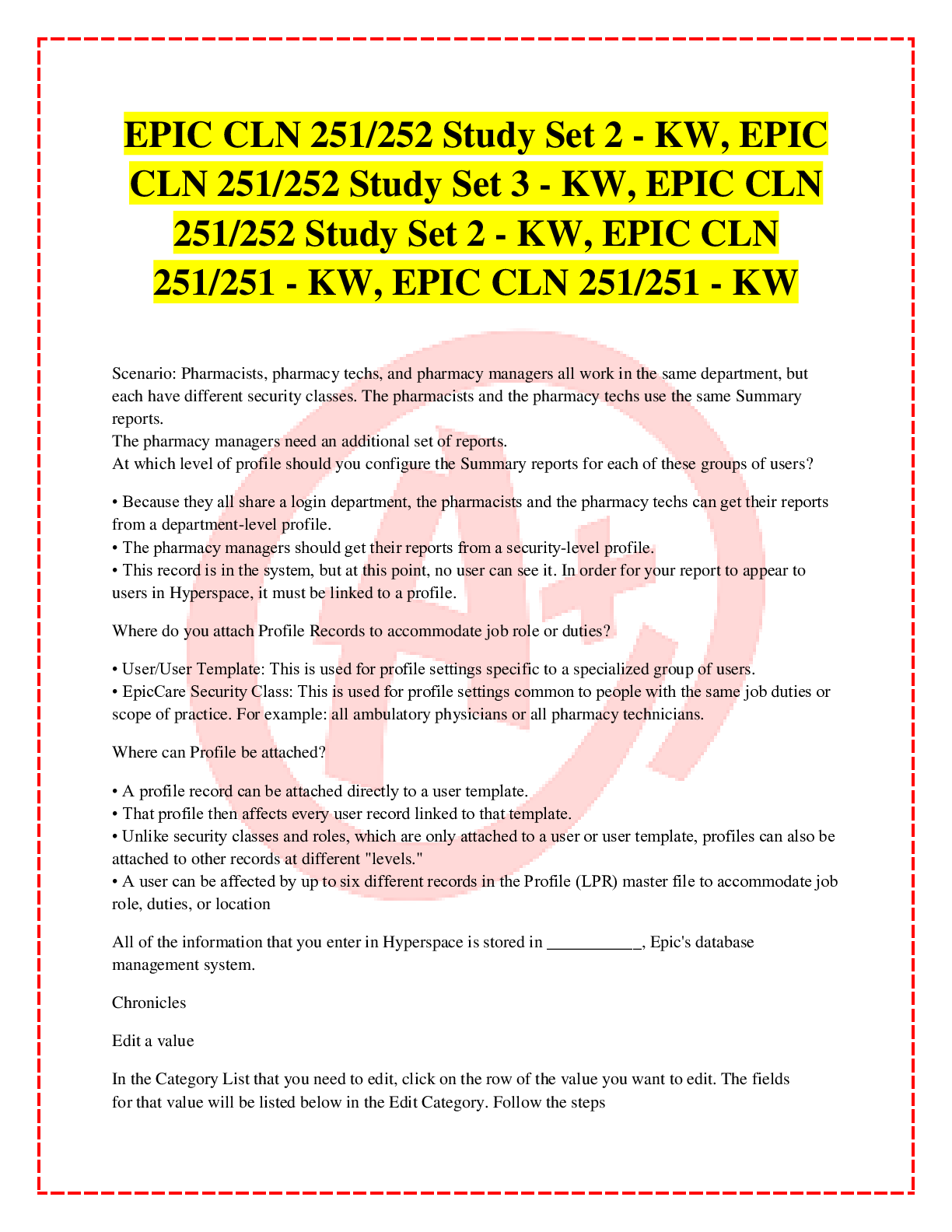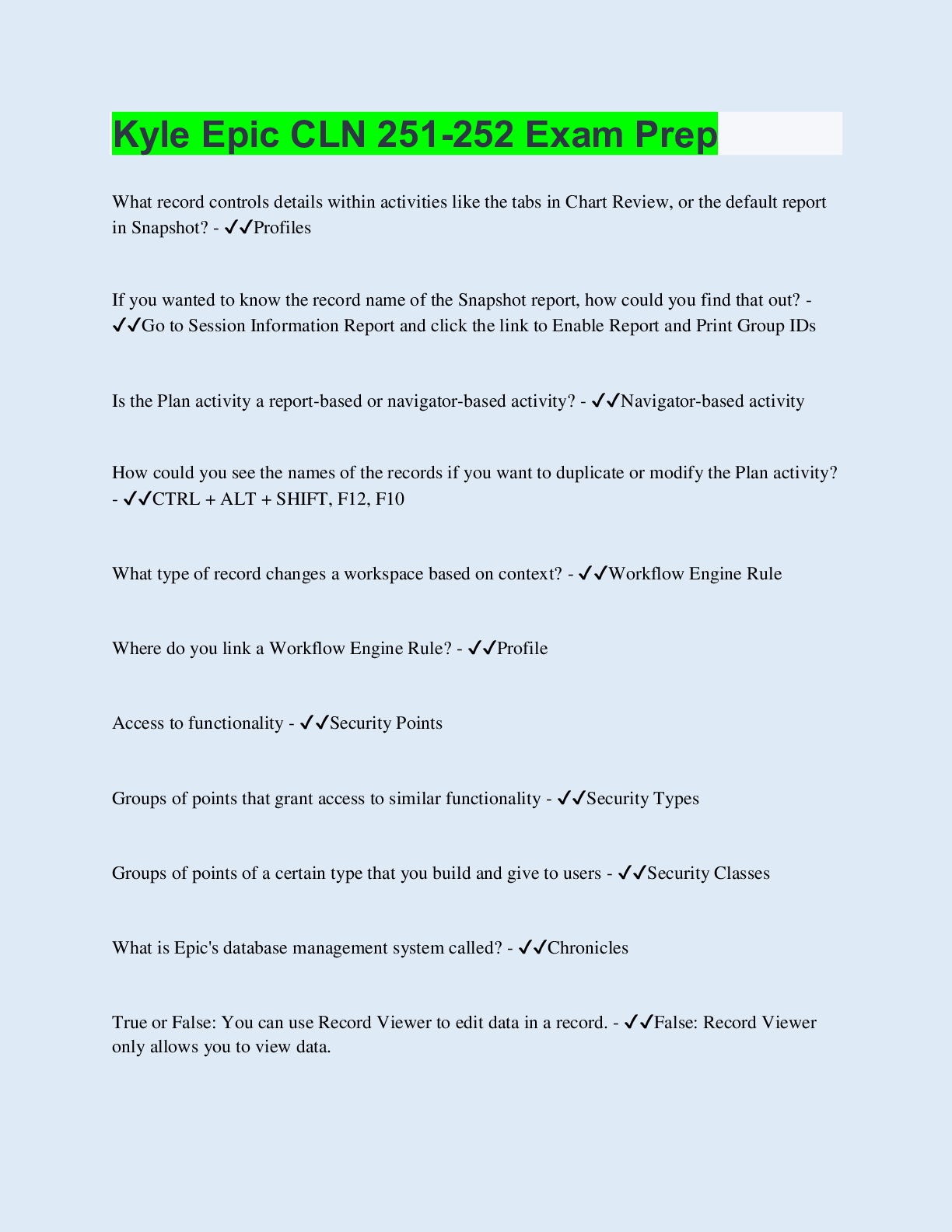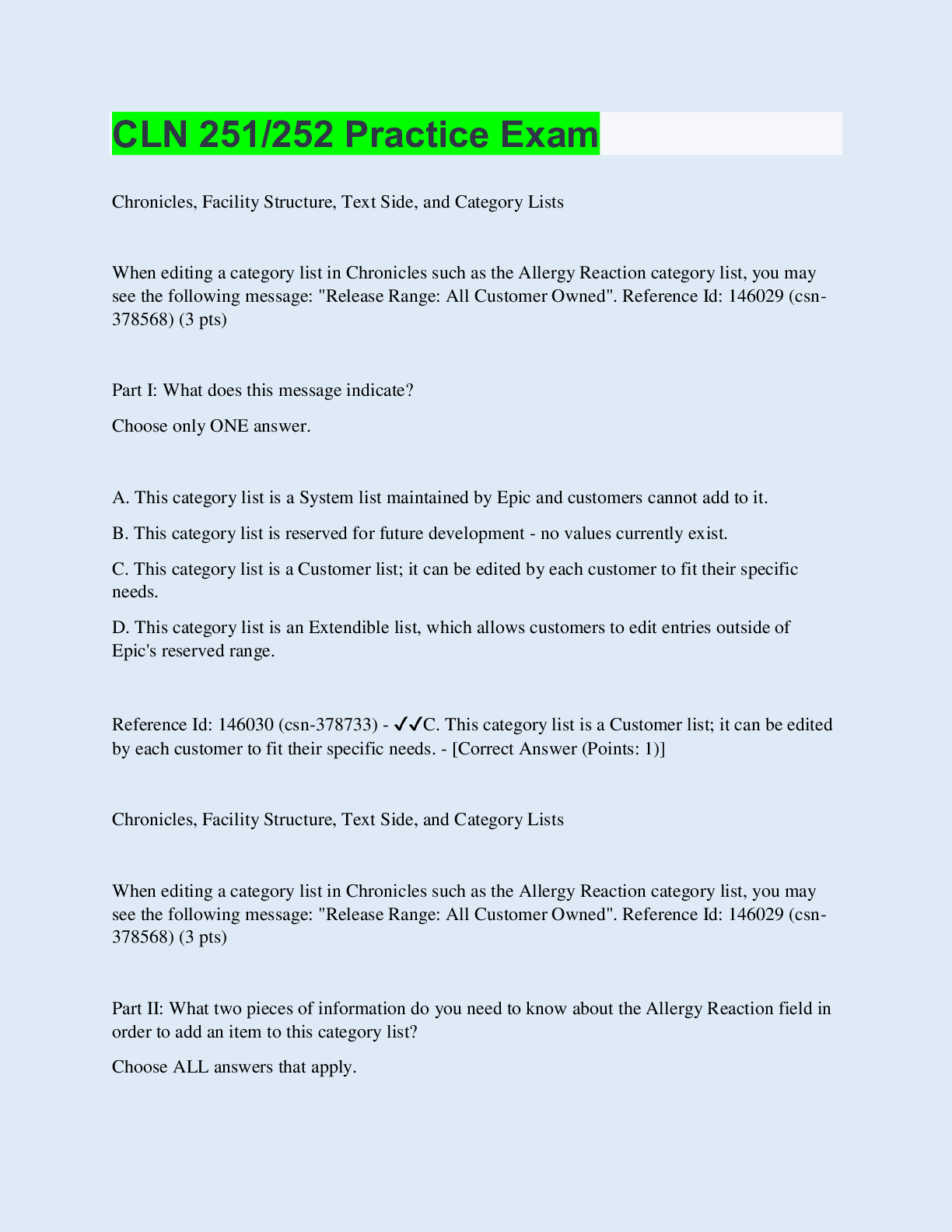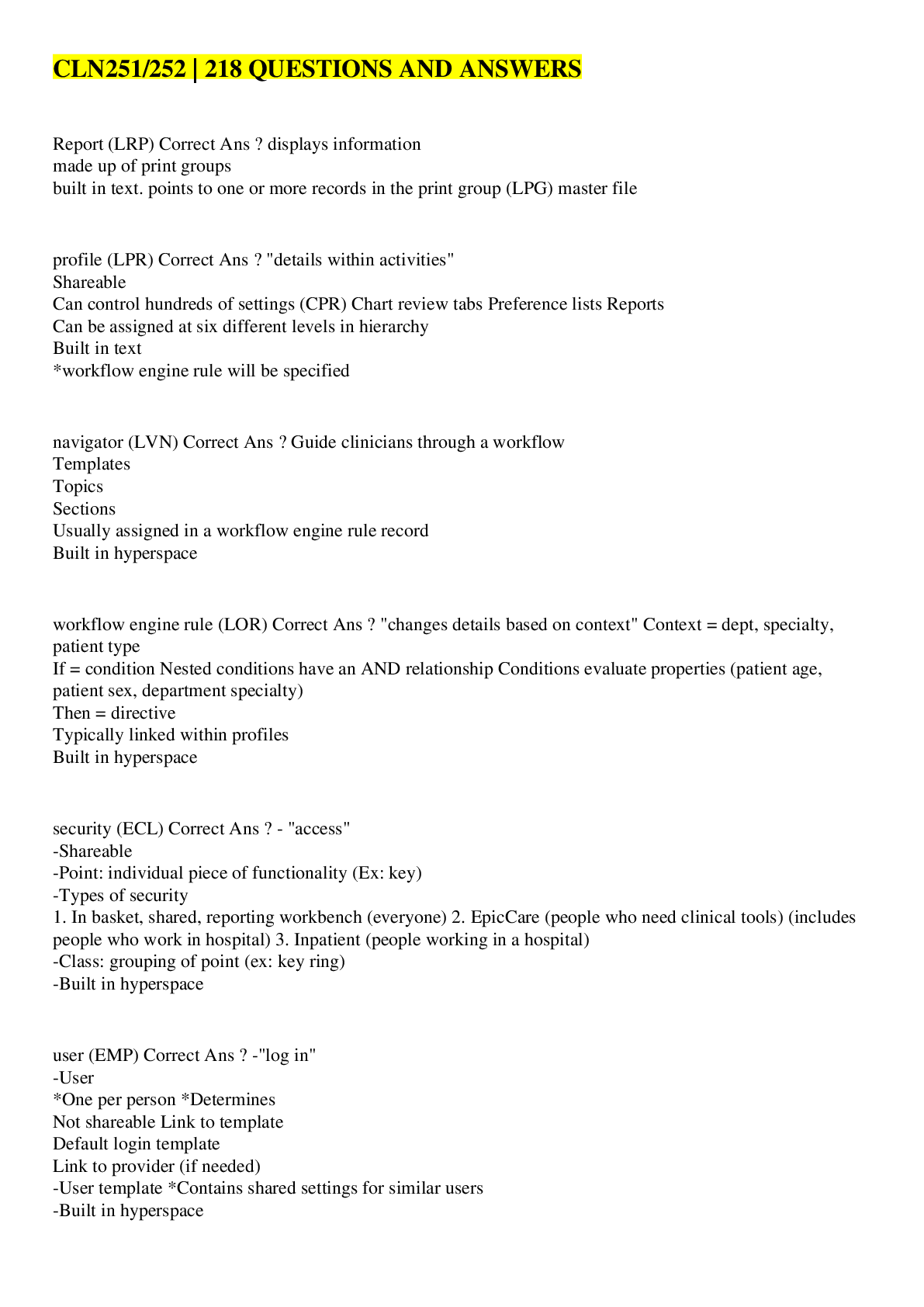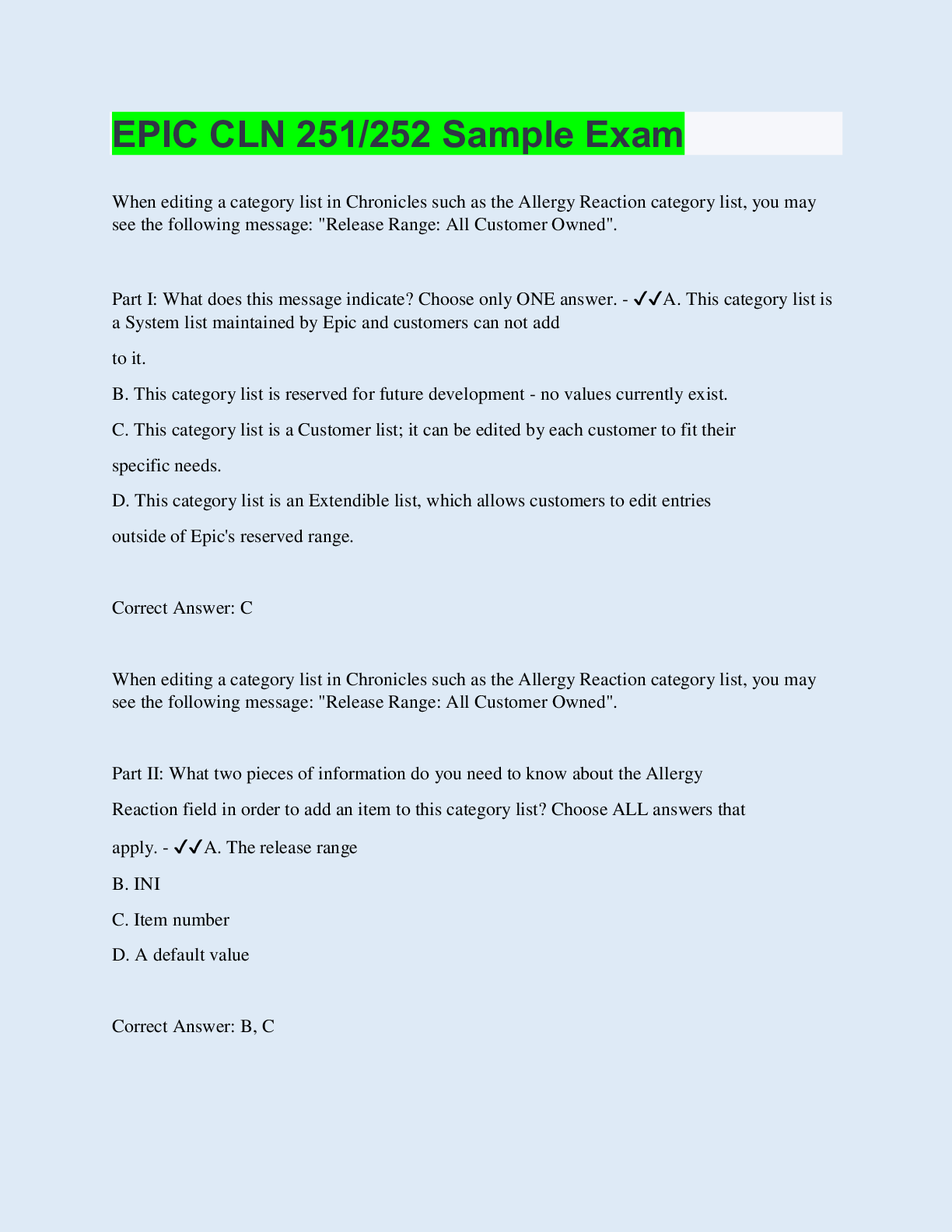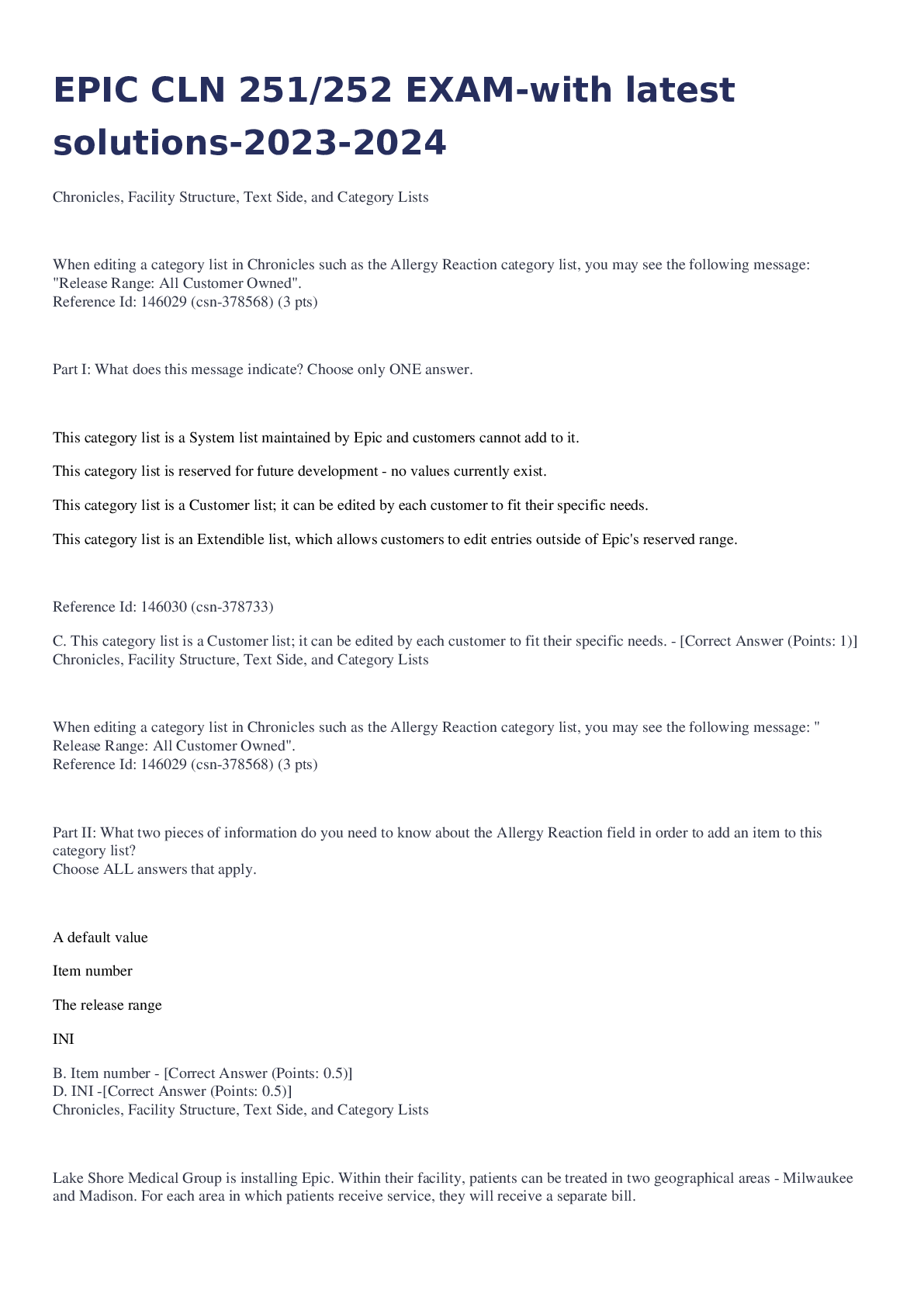Environmental Science > EXAM > Unit 2 Milestone 2 with answers,100% CORRECT (All)
Unit 2 Milestone 2 with answers,100% CORRECT
Document Content and Description Below
Environmental scientists cite several challenges to protecting endangered species. All of the following are difficulties faced by those working to protect an endangered species EXCEPT: • Protect... ion efforts may be slowed because of difficulty enforcing new regulations. • Extinction is natural in nature and its rate of occurrence has remained steady. • Scientists who are focused on a single species may not recognize another species in peril. • Fundraising can be more difficult if the species is not perceived as valuable. 2 Which of the following is a non-renewable resource? • Petroleum • Wood • Biomass • Wind 3 According to the graph, how many months did it take for the deer population to reach carrying capacity? • 6 • 10 • 4 • 8 4 It was raining as we began our long hike. We took a trail to the east and left the ocean behind us. Soon we were in a large grove of eucalyptus trees. Coming out of the forest, the trail became rocky and the incline became steep. The rain had stopped, but now I was chilly. “I wish the climate would make up its mind,” I grumbled. My mother, a biologist and nature lover, gently corrected me. “Weather is what’s happening at the moment, dear. Climate is weather a certain area has over years.” Which of the following best describes why the temperature has dropped? • The hikers are climbing to a higher elevation. • The hikers are walking into a valley. • Rain along the coastline is following them. • A large lake is nearby. 5 Choose the statement that correctly describes how carbon is cycled. • Animals consume carbon and release oxygen, and plants consume oxygen and produce carbon. • By converting it into sugars, plants relay carbon to animals, and animals convert it to oxygen. • Through photosynthesis, carbon dioxide is changed into food, with oxygen as a waste product. • Plants consume carbon and release oxygen, and animals consume oxygen and release carbon. 6 Select the statement that refers to an exponential population growth model. • The slope of the graph in this model is determined by changes in birth and death rates. • This model considers an environment’s biotic and abiotic conditions. • This model of population growth is more realistic. • The slope of the graph in this model is determined by natural resource availability. 7 Select the statement that is indicative of valuing species for their intrinsic value. • Cotton is an important crop because it can be made into fibers for clothing. • Wilderness areas are places that provide opportunities for reflection and enjoyment. • These wetlands must be protected because they provide flood control. • Factory farming should be abolished because it condemns chickens to short, miserable lives. 8 Select the food chain that is in the correct order, starting at the first trophic level. • Earthworm – Acorn – Squirrel – Hawk • Earthworm – Hawk – Squirrel – Acorn • Acorn – Squirrel – Hawk – Earthworm • Acorn – Earthworm – Squirrel – Hawk 9 A piece of land was cleared of trees many years ago but has been left alone since. New trees have grown in and restored the land to its previous state. This ecological process is called __________. • Species interaction • Ecosystem management • Primary succession • Secondary succession 10 A new housing development was built at the end of a newly constructed highway. Forests with a population of black bear surrounded both sides of the new development. Select the most likely outcome of this habitat fragmentation on the local bear population. • The bear population may move deeper into the forest. • Bears may be restricted from food access and breeding opportunities. • The bears may break into two separate populations. • The bears may be captured and relocated to ensure their survival. 11 Which statement is NOT true about energy and trophic levels within a food web? • About 90% of energy available at one trophic level does not transfer to the next. • Most of the energy between trophic levels is lost in the form of metabolic heat. • Secondary production introduces only 1% of new energy to the food chain. • The rate at which energy accumulates in plants depends on temperature, sun, and water. 12 Which of the following is an example of symbiosis? • Rabbits and deer both consume grass. • A honeybee takes pollen from a flower. • A blue jay uses a nest built by another jay. • Bats snatch mosquitoes out of the air. 13 Choose the statement that is NOT true about conditions within the given biome. • Tundras are very cold with very little rainfall. • Temperate grasslands are in the wetter areas of the temperate zone. • All deserts have extremely low precipitation levels. • Steppes are cold grasslands with little precipitation. 14 Select the correct definition for ecosystems ecology. • It is the study of the density, variability, and sex ratios of inhabitants of a given environment. • It is the study of living and non-living components in a given environment. • It is the study of organisms and their relationships to their environments on a global scale. • It is the study of interactions among multiple species in a given environment. 15 Select the FALSE statement about photosynthesis and carbon cycling. • A carbon-dependent reaction in photosynthesis fixes carbon dioxide into sugars. • Cellular respiration is the release of sugars as energy. • Respiration for animals is the intake of oxygen and the output of carbon dioxide. • Photosynthesis is the process that produces all life energy. 16 Choose the statement about nitrogen and nitrogen fixation that is FALSE. • The roots of certain plants contain microorganisms that absorb nitrogen from the atmosphere and pass it on to animals. • Nitrogen in the atmosphere is not useable, so it needs to be “fixed” to be of benefit to plants and animals. • Nitrogen makes up about 22% of the atmosphere and is an important biological compound found in DNA. • When an animal dies, microorganisms convert the nitrogen in its proteins and muscles into a form that plants can eat. 17 Which of the following is NOT an example of overexploitation? • Ginseng is slow growing, produces few seeds, and is highly sought for its medicinal properties. • The passenger pigeon population in America was in the billions before they became extinct. • Each time salmon are harvested from a fish farm, new salmon are brought in to replace them. • Twenty-five million bison once roamed the American landscape; by 1880, only 1,091 remained. CONCEPT Overexploitation I need help with this question 18 Choose the example of a decomposer in the food chain. • A wildcat consumes the rabbit. • A head of lettuce grows in a garden. • A rabbit eats lettuce growing in a garden. • An earthworm consumes a wilted lettuce leaf in a trash pile. 19 Choose the statement about the impact of an invasive species that is NOT true. • The health of an ecosystem often improves. • Native species can be displaced or killed. • Invasive species can take over forests or croplands. • Humans can be exposed to unknown pathogens. 20 Emergent properties at the ecosystem level include all of the following except __________. • Interactions between biotic and abiotic factors • Influence on global occurrences • Number of communities • Connections between communities 21 Select the example that describes a non-native species. • Populations of deer and wolves in Arizona have evolved in relationship with each other. • Domestic livestock multiplied rapidly throughout eastern North America after their introduction by English colonists. • A species of parrot has evolved to occupy a key niche within the Amazon rainforest ecosystem. • This particular species of orchid has remained within the same environment for hundreds of years. 22 Which list correctly orders the examples of organism, population, community, and ecosystem? • Elephant herd – grasslands – lions in the grasslands – river and trees • Tundra – moss – reindeer that eat moss – rocks and ice • Tadpole – pond – frog – fish and insects in the pond • Deer – herd of deer - deer and trees in forest – rocks and ponds around the forest 23 Which statement accurately describes the Savanna? • This biome features forests and grasslands that go dormant during the winter. • This biome features a level of permafrost and a short growing season during the winter. • This biome features tropical grasslands and is located near the equator. • This biome features high levels of biodiversity and is located near the equator. 24 Which of the following is a strategy associated with restoration ecology? • Creating a new wilderness area to limit human interactions with an endangered species. • Examining the biological structures of living and non-living components in a given environment. • Reintroducing native plant and animal species to a piece of land devastated by deforestation. • Studying an environment closely to determine ways to maintain biodiversity and a healthy ecosystem. 25 Efforts to stop or counteract deforestation include all but __________. • Introducing new plant and animal species • Planting new trees • Establishing green zones and natural preserves • Regulating logging practices [Show More]
Last updated: 1 year ago
Preview 1 out of 6 pages
Reviews( 0 )
Document information
Connected school, study & course
About the document
Uploaded On
Nov 02, 2020
Number of pages
6
Written in
Additional information
This document has been written for:
Uploaded
Nov 02, 2020
Downloads
0
Views
214




